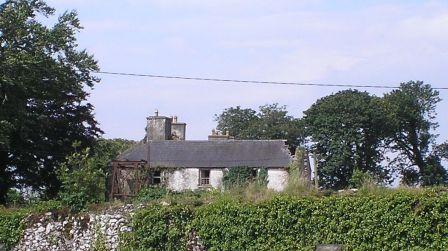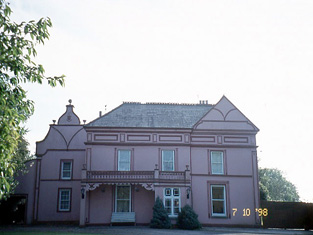Meanus House
Houses within 5km of this house
Displaying 15 houses.
Houses within 5km of Meanus House
Displaying 15 houses.
| House name | Description | |
|---|---|---|
| Magh House or Edenburn | Colthurst Bateman was leasing a property to Edward F. Day at the time of Griffith's Valuation, when it was valued at £28 15s. On the 1st edition Ordnance Survey map it is labelled as Magh House but on the 1895 edition it is called Edenburn House. Lewis records it as the seat of W. Seely in 1837.The Ordnance Survey Name Books of the 1839s noted that this was the residence of the Sealy family and had been preceded by Rockfield House, the ruins of which were still discernable. Magh is described as "handsomely built of square form, three stories high and cost £2000". Later in the nineteenth century it was occupied by Edward Fitzgerald Day and then by Samuel Murray Hussey, agent to the Kenmare and other estates. In 1906 it was owned by John Hussey and valued at £24. It was used in the later twentieth century by the Southern Health Board as a hospital/nursing home and is still extant. | |
| Maglass House | William Ledmond was leasing Maglass House to Daniel Hilliard at the time of Griffith's Valuation when it was valued at £11 15s. Lewis records Maglass as the seat of W. Ledmond in 1837. The Ordnance Survey Name Books record it as the residence of Daniel Hilliard but originally built by the Ledmond family. Bary, however, states that it was possibly built ty the Babington family who lived there in the eighteenth century. In 1786 Wilson refers to "Maglass" as the seat of Wiliam Sealy. It was later occupied by the Ledmonds who later sold it to the Roche family. Redmond Roche is recorded as residing there in the 1870s. In 1906 it was owned by the representatives of Redmond Roche and valued at £18 5s. It is now derelict and ruinous. |

|
| Crag House or Rockville | Robert Leeson was occupying this property at the time of Griffith's Valuation when the lessor was William Miles. It was then valued at £18 15s. On the 1st edition Ordnance Survey map the house is labelled as Rockville. Bary quotes O'Donovan who claimed the owner in the 1830s was John Marshell Myles. The house is still extant and the well-known Crag Cave complex is located in the demesne. See www.cragcave.com | |
| Castleview House | At the time of Griffith's Valuation, Robert Leeson was leasing this property to Edward Hartnett when it was valued at £11. On the 1st edition Ordnance Survey map it is labelled as Charter School but by the 1893 edition it is named as Castleview House. Bary indicates that the property was originally built in the mid-eighteenth century and operated as a Charter School until the 1820s. Papers relating to its operation as a charter school are included in Ms.17,973 [Quane Papers] in the National Library of Ireland. It was later enlarged by the Hartnett family who occupied it for much of the nineteenth century. It is still extant and occupied. |

|
| Tobermaing House | Robert Chambers was leasing a property which included a mill to James Chambers at the time of Griffith's Valuation, when it was valued at £26 15s. In the 1830s the Ordnance Survey Field Name Books record Lady Franks as the proprietor of this townland and William Bailey as resident in the house. Bary states that the mill was run by the Bailey family and that the property was later owned by the Roche family. In the 1990s it had been converted into a bar and restaurant. | |
| Camp Lodge | At the time of Griffith's Valuation, Richard Chute was leasing this property to George Hewson, when it was valued at £5 10s and part of a farm of 350 acres. In the 1830s, the Ordnance Survey Name Books describe it as "a small cottage, one story high, the residence of John Hussey". It was offered for sale in the Land Judges' Court in 1883 when it was described as a "comfortable dwelling house, suitable for a gentleman's family". Bary indicates that it had been the home of the Twiss family earlier in the nineteenth century. It is still extant. | |
| Mullaghmarky House | Richard Chute was leasing this property to John Sealy at the time of Griffith's Valuation, when it was valued at £10 10s. In the 1830s, the Ordnance Survey Name Books describe it as " a large house, two stories high, with offices, plantation and ornamental garden, the residence of Eusebius Sealy". Bary states that the Sealys had occupied it since the early part of the nineteenth century. It is still extant though not occupied. | |
| Tullig House | Henry Herbert was leasing this property to William England Young at the time of Griffith's Valuation, when it was valued at £7. In the 1830s, the Ordnance Survey Name Books describe Tullig as "a large house, two stories high, with offices and a garden, the residence of Widow Chute". Earlier, in 1786, Wilson notes Tullig as the seat of Mr. Sandes. Bary states that the house was originally built by the Saunders family and that it later passed to the Brosnan family who have lived here for several generations. Bary also mentions that William E. Young was married to Agnes Sealy and lived at Ballinvariscal House in Novahal parish. | |
| Sandville House | Robert A. Thompson was leasing this property from the Herbert estate at the time of Griffith's Valuation, when it was valued at £11 5s. Bary notes that it had been frequently occupied by agents to the Herbert estate through the nineteenth century. It is believed to have been built by them in the late seventeenth century. The house is still extant and occupied. | |
| Clashganniv House | John Powell was leasing this property from the Herbert estate at the time of Griffithf's Valuation, when it was valued at £10. Let also notes it as his residence in 1814 though he refers to it as Sandville. Bary states that the Powells continued in residence until the early twentieth century. Clashganniv is still extant and occupied. |

|
| Kilcow House | Robert A. Thompson was leasing Kilcow House from the Herbert estate at the time of Griffith's Valuation, when it was valued at £17 10s. Bary notes that the Herbert family lived here for a time in the eighteenth century before moving to Muckross. The house is still extant and occupied. | |
| Annamore House | Maunsell Andrews was leasing this property to Margaret Roche at the time of Griffith's Valuation, when it was valued at £5 5s, on a holding of 170 acres. Barry quotes O'Donovan, who claims the house was built by the Meredith family in the early eighteenth century. It may also have been associated with Lord Northcote's estate. The Roche family occupied the property since the 1840s. | |
| Ballinvariscal House or Mount Prospect | William Massey was leasing this property from TCD Estates at the time of Griffith's Valuation, when it was valued at £5 15s and part of a holding of over 400 acres. In 1814 it was the residence of Roger Lombard. Bary indicates that the house had several different owners in the nineteenth century when it was known as Mount Prospect. It was sold around 1900 and is still extant and occupied. | |
| Woodville (Nohaval) | Richard Norris was leasing this property to Rev. John Fitzgerald Day at the time of Griffith's Valuation, when it was valued at £27. Lewis mentions Nohaval House, as the seat of Rev, Fitzgerald, which seems to be the same property. Bary quotes O'Donovan who indicated that this house belonged to the Norris family. She indicates that the house later passed to Fitzgerald-Lombards and Hicksons. It was sold in the early twentieth century and is still extant and occupied. | |
| Ballyegan | At the time of Griffith's Valuation, Richard Norris was leasing this property to John Millward (senior), when it was valued at £6. In 1814 Leet noted John Hartnett as resident at Ballyegan. Bary indicates that the Millwards occupied this property until well into the twentieth century though they moved to a different house. The original house was demolished to make way for a quarry. |

